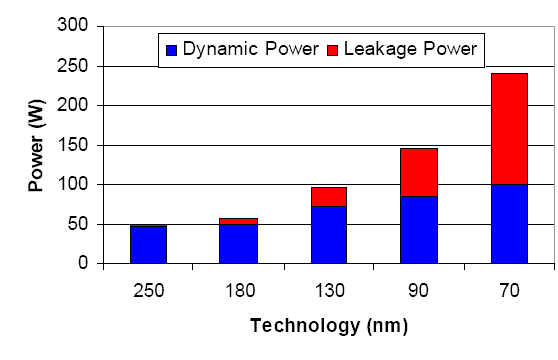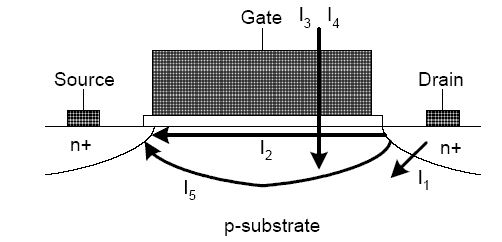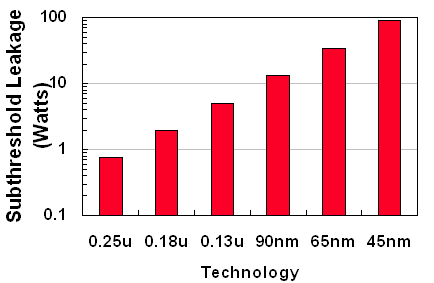The Quest for More Processing Power, Part One: "Is the single core CPU doomed?"
by Johan De Gelas on February 8, 2005 4:00 PM EST- Posted in
- CPUs
When a CPU becomes a sieve
The real problem is leakage power, and the Intel power graph below illustrates this perfectly.

Fig 2. "Leakage power grows exponentially ".
As you can see, dynamic power - which does useful work - has increased relatively slowly despite the increase in CPU complexity. Leakage power, however, increases exponentially, and not linearly. It has grown quickly from a "minor nuisance" to a "circuit killing monster".
Leakage is comparable to a small hole in a waterhose of a firefighter. The more pressure (i.e. the higher the core voltage), the bigger the hole gets, and thus, the more water that leaks to the ground. The thinner the walls of the tube (i.e. smaller process technology), the quicker the holes become bigger, and the more water you lose, the harder the pumps must work to get the same amount of water to extinguish the fire. If the pumps overheat, you better throttle them down, or they will cease to work after a while.
Power Leakage happens as a part of the current, which is supposed to make our transistors switch leaks away in the substrate and finally in the ground. There are several leakage currents, but the two most important ones are the gate oxide tunnelling current and sub-threshold leakage.[3]

Fig 3. I3 is the Gate oxide tunnelling currents, I2 is the Sub-threshold leakage current
Gate oxide tunnelling (I3) currents get more important with smaller process technology as the gate oxide that is supposed to insulate the transistor becomes thinner and thinner. As a result, current that is going through the transistors leaks away - the gate oxide becomes a sieve instead of being the "wall of a tube".
Sub-threshold leakage (I2) transistor is the leakage current flowing through the transistor when it is supposed to be turned off. To understand this, we got to back to basic transistor technology.
Normally, a voltage threshold of x volts is needed to get current across the transistor, with x volts being the threshold. This way, the transistor is being used as a switch with a binary function: more or equal to threshold voltage = ON = 1, less than the threshold voltage = OFF.
The point that you have to remember is this: ideally, as long as the threshold voltage is not reached, no current should run through the transistor. However, as transistors and interconnects get smaller and smaller (smaller process technology), the insulation between drain and source gets worse and worse. As a result, a small leakage current gets through the transistor (I 2) even though the threshold voltage is not reached (the Transistor is off).
That subthreshold leakage has become a major problem, which has been made clear by Shekhar Borkar [5] (Intel Fellow, Director of Circuit Research). He illustrated this by the logarithmic graph below.

Fig 4. Subthreshold leakage - notice the logarithmic scale!
Subthreshold leakage was only a small problem at the time of Willamette - the leakage problem wasted a few watts at 180 nm. The graph is based on Moore's law: every two years, the number of transistors doubles. As you can see, without countermeasures, it wouldn't be interesting to use devices that make use of 45 nm technology. They would simply leak too much power, up to 100 Watts!
And subthreshold leakage is only part of the leakage problem. Together with gate oxide tunnelling, CPUs made of 65 nm technology would leak more power than what they need for making the transistors switch. It is comparable to a fuel tank that has so many holes, causing it to leak more gasoline to the ground than what the fuel pump can pump to the engine.
Let us check the third and last problem for high performance CPUs.
Wire delay
It is hard to imagine that the little wires - the metal interconnects - between transistors can be a limiting factor. About twenty years ago, transistor switching speeds were pretty low, and wire delays were completely ignored. However, as process technology became better, transistors were capable of switching much faster. Right now, the fastest transistors in the labs can attain 100 GHz (the record being around 300-500 GHz) and more. So, transistor switching speed still has a lot of headroom.
The tiny wires between the different transistors are still not the problem. Functional blocks are also wired to the TLBs (Translation Lookaside Buffer) and caches. The real problem is these global wires - they are a lot longer . If the RC delay is too high, the clock speed will have to be reduced to get a working CPU.
The speeds at which signals travel through the global wires (from logic blocks to the caches, for example) are quite a bit slower than what the maximum speed (speed of light) allows. The reason is the resistance (R, Ohm) and capacitive resistance (C) of the wire. As the whole CPU was made with smaller process technology, the wires also shrunk. You probably know from your lessons of physics that resistance increases as the cross section of the wire gets smaller and the length of the wire gets longer. So, if you shrink a wire, the effect of the shorter length is completely negated by the smaller thickness of the wire. You could make the wires thicker, but it wouldn't be easy and that would increase the capacitance of the wire. The result is that wire delay remains, more or less, the same (in nanoseconds).
However, gate switching speed improves a lot with smaller transistors (for example, 100%). So, while RC delay improves with a very small percentage (or nothing all), gates might switch up to 100% (simplified example) faster as process technology improves. The RC delay of the global wires becomes more a bottleneck that makes bumping up the clock speed hard. Modern Integrated Circuits (ICs), such as CPUs, must be partitioned, as a signal can travel for a time slightly less than the length of one clockpulse.










65 Comments
View All Comments
WhoBeDaPlaya - Thursday, February 10, 2005 - link
Ain't no way you can get those repeaters out of there - that's already the optimum solution for driving the large load (interconnect). It probably equalizes the stage effort required (you can work out the math and find that for multi-stage logic, the optimal config is that each stage has the exact same effort level). Eg. instead of driving an interconnect with a "unit" inverter, it might be more feasible to drive it with a chain of them, each with different fan in/out. Repeater insertion is tricky and (as far as I know) can't readily be automated.Interconnects are getting to tbe point where traversal of a die diagonally can take multiple clock cycles. Some folks are suggesting that a pipelined approach could be extended to interconnects, esp. clock trees. But the most fun problem (for me at least :P) is the handling of inductance extraction - how in the h*ll do you model it accurately? High-speed digital design == Analog design. Long live analog / mixed-signal VLSI designers :P
fitten - Thursday, February 10, 2005 - link
[quote]Well-written multicore-aware code should have the number of cores as a _variable_, so you just set it to 1 on a uniprocessor platform.[/quote]Sometimes parallel algorithms aren't very good for serial execution. In these cases, you may actually have one algorithm for multiple processors and another algorithm for a single processor.
[quote]So, if Intel were to use less repeaters the heat output could be lowered significantly. [/quote]
Well... I'm sure the Intel engineers didn't just up-and-say one day, "Hey, I know something cool to do... let's put some more repeaters into the core." I'm sure there's a reason for them being in there. It would probably take a bit of redesign to get the repeaters out. (I'm pretty sure this is what you meant, but I just wanted to clarify that stuff like repeaters aren't just put into a CPU for no reason. Things like repeaters are put in because there wasn't a more viable solution to some signalling problem that's there.)
sphinx - Thursday, February 10, 2005 - link
So, the reason for the Prescott's shortcomings is the use of too many repeaters as shown in the image of the Itanium 2. If I remember correctly, the article said that the repeaters were using too much power as well. So, if Intel were to use less repeaters the heat output could be lowered significantly.AtaStrumf - Thursday, February 10, 2005 - link
Nice article and pretty easy to understand as well. I'm happy to hear that there may still be hope for controlling the power leakage, because without it I just can't see anybody getting beyond 65 nm, since even 65 nm will, without improvements, leak almost 3 times as much power as 90nm does now.Anxiously waiting for E0 A64 to see what AMD has managed to cook up.
mickyb - Wednesday, February 9, 2005 - link
There are plenty of multi-threaded apps out there. I am not sure pure single threaded apps exist any more outside of "Hello World" and some old Cobol/FORTRAN ports that are on floppy.Quake and UT have been multi-threaded for a while. Quake was multi-threaded when I had a dual Pentium pro. There were even benchmarks. The benefits seen with hyper-threading also show that many apps are multi-threaded. The performance gain was negligible due to the graphics drivers and OpenGL/DirectX not being thread optimized. I am sure that has been worked out by now.
Multi-threading is not all about making use of multiple CPUs. There are many conditions where a program would be stopped dead in its tracks waiting for a response from some outside program or hardware device. You can solve this with events, multi-process, multi-threading, call-backs, etc. Goal wise, they are related. In the Winders world, threading is the method of choice.
I really can't believe there are still arguments going on about programs not being multi-threaded. This is not that much of an issue any more. Even if your apps is not threaded, the OS is and it can run on one CPU while your app runs on the other. Or if you have 2 apps, then they can run on different CPUs.
With all that said, I agree with the thought that creating performance for all applications is better served using a faster single core CPU than dual CPUs. I think this way because when you have a unit of work to be done (even with multiple threads), it is more likely to be done quicker with a single CPU that is capable of the same computing power as 2 CPUs. I single unit of work will ultimately be smaller than a thread in all cases. The smallest is the instruction set.
Now...with that said, if the limiting factor is technology and they cannot obtain the equivalent performance of a dual core with a single core, then it makes since to go dual core to obtain it, especially with the power leakage. I like the thinking behind dual core on a laptop, but am skeptical about the part that says turning the CPU off and on rapidly to keep it cool and efficient. It will probably work if it isn't turned on and off too quickly, but heat spreads pretty quickly. You wouldn't even get past POST without a heat-sink and that silicon insulator keeps everything pretty cozy.
NegativeEntropy - Wednesday, February 9, 2005 - link
Johan, another excellent article, I'm looking forward to part 2.Evan Lieb - Wednesday, February 9, 2005 - link
It's pretty much impossible to get a "newbie" explanation of CPU architectures without a least a basic understanding of how CPUs work. Rand's suggestions were quite good, you should start there if you're overwhelmed by Johan's explanations IceWindius. It also wouldn't hurt to start with Anand's CPU articles from last year.Rand - Wednesday, February 9, 2005 - link
"I wish someone like Arstechinca would make something really built ground up like CPU's for morons so I could start understanding this stuff better."You may want to read parts 1-5 of "The Secrets of High Performance CPUs"
http://www.aceshardware.com/list.jsp?id=4
A bit outdayed now, as it was written in 99' if I recall correctly but it's still broadly relevant and a nice series of articles if your looking to get a better understanding of microprocessors without being drowned in the technical side of things.
ArsTechnica also has some good articles with a newbie friendly slant.
There are some excellent articles at RealWorldTech as well, but their definitely written for engineers rather then the average person.
Unfortunately most of the more noteable books like those by Hennessy & Patterson assume you've already some knowledge of computer architectures.
stephenbrooks - Wednesday, February 9, 2005 - link
#46, Well-written multicore-aware code should have the number of cores as a _variable_, so you just set it to 1 on a uniprocessor platform. I also think there already exists a multithreaded version of one of the big engines (Quake, UT?) that apparently does not lose any performance on a single core either.But I agree with the main thrust of your post, which is "Buy AMD".
Noli - Wednesday, February 9, 2005 - link
Not to belittle dual core development and I know there are a lot of people who run technical programs that will benefit from dual core on this site, but when I spend a small fortune on a pc, the primary driver is being able to play the most advanced games in the world. Unfortunately, I don't feel multi-threaded game code is going to get written for a longggggg time (what's the point of reducing potential customers?). How long till a very large percentage of users have dual cores? End of 2006 at the very earliest? So it's really a just a theoretical interest till then for me...